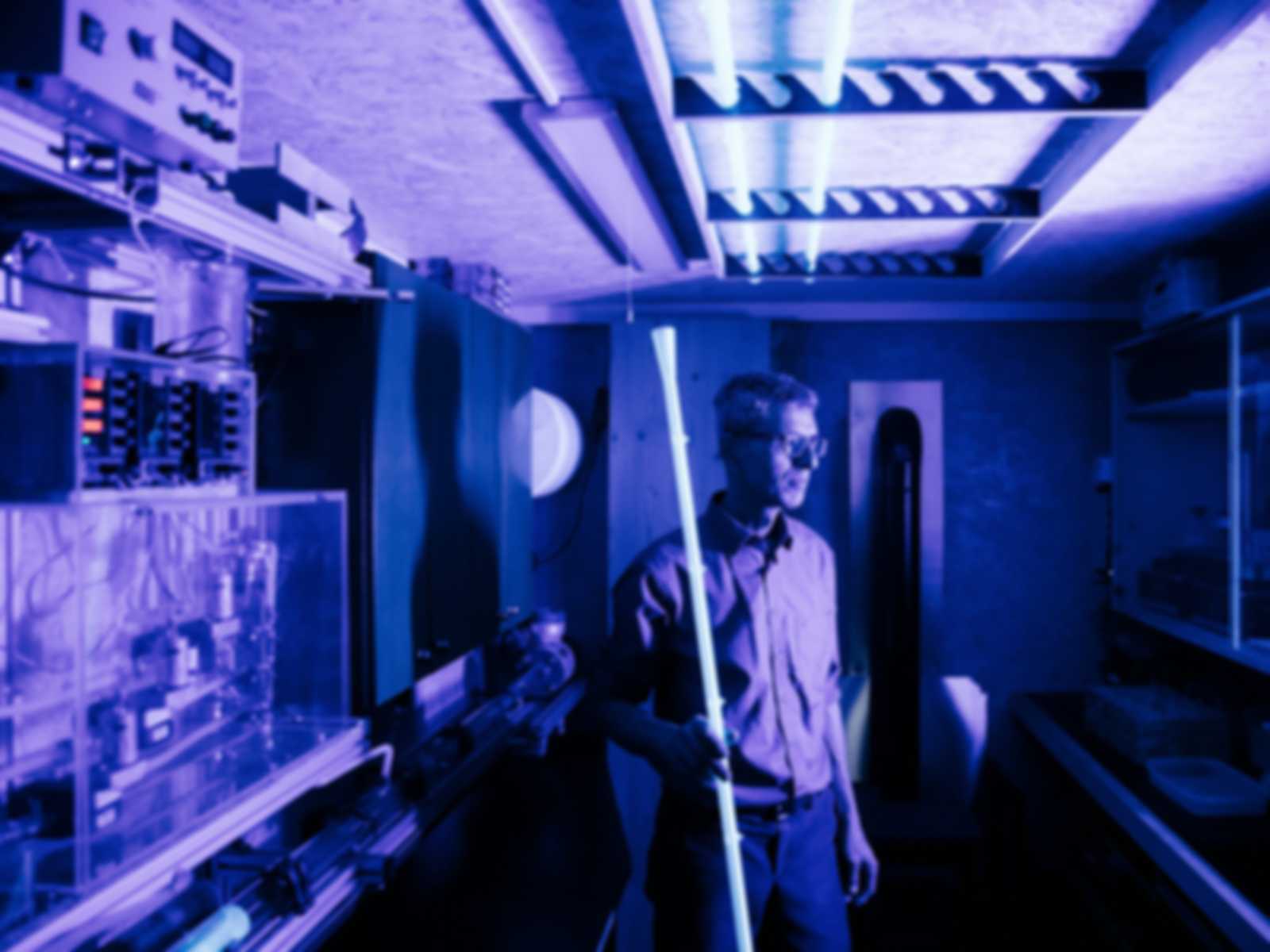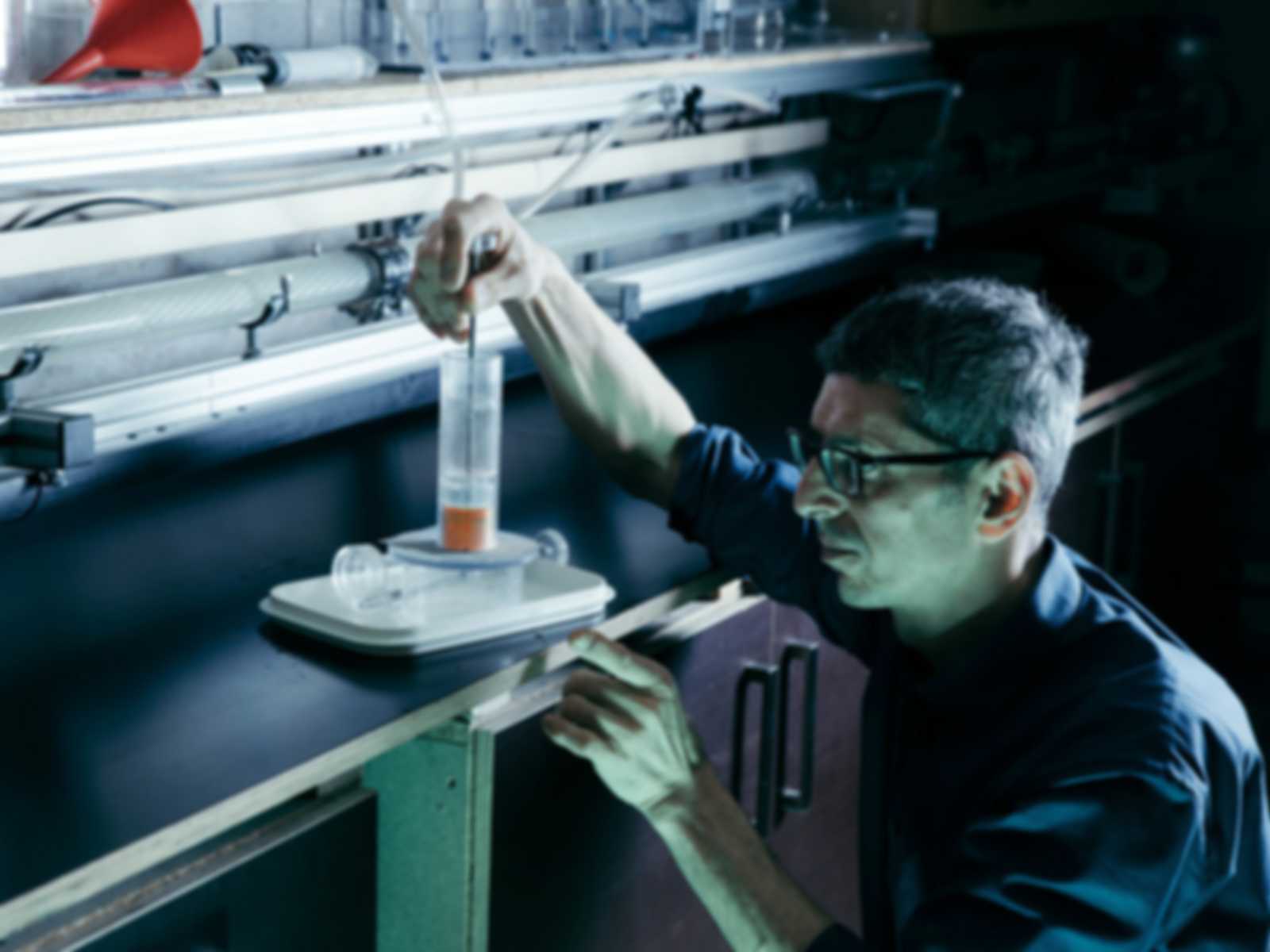
Tayyar Bayrakci is friendly and modest, low-key in conversation, but obsessive in the best sense of the word when it comes to his work. In 2009, at the age of 40, as a late student, he received a scholarship from the Foundation for the Promotion of the Talented and used it to totally immerse himself in what he calls a "super-relevant topic." He studied "regenerative energies" and came into contact with the topic of "rotating flows in pipes" during his bachelor's thesis. The beginning of a research obsession - from which we will all benefit. For the past 12 years, Bayrakci has been one hundred percent involved in his project - and in an extremely modest living and tinkering environment. He lives in Munich, his lab is in a truck container, 6 m x 2.50 m x 2, 50m. "My walk to work is eight meters. And I can say without exaggeration that I work in two shifts. So, in a manner of speaking, I work through." But what exactly is he working on?
In short, on revolutionizing water purification.

The innovation: using fluid forces and cyclone technology for water purification. Tayyar Bayrakci has invented CyFract, a device and process to remove dirt or suspended solids from water. Without filters and chemicals.
To explain this, we need to take a technical step back:
Filterless dirt separation works conventionally by means of so-called cyclone technology. Dust-laden air, for example, is fed into a separation chamber and set in rotation. Centrifugal force causes heavy particles to be forced outward and light particles inward. This works well for separating dust from the air, such as in carpentry shops. Bayrakci's field of research, however, is water, and such separators - based on existing cyclone technologies - are unsuitable for suspended solids in water. This is because they often have to deal with dirt particles that have a similar density to water. The result: particle chaos. Existing cyclone technologies can separate such suspended particles, such as microplastics, if at all, only with very high energy input and extremely high pressures.
That's why Bayrakci's invention is based on a novel uniflow hydrocyclone technology. The water passes through a special pipe, the flow is optimized to a degree not thought possible, particles accumulate near the outer wall and two water flow components leave the construction space in the same direction. That's why it's uniflow.
That alone is tricky, complex and new - but it's far from all the innovation in CyFract.
The process does not use centrifugal forces, but the much more dominant fluid forces. These forces enable airplanes to fly, for example, because air flows around an airfoil faster above than below. An underpressure is created on the upper side, and the wing is virtually sucked upwards.
Bayrakci, in endless detail - and with all his expertise as an excellent master boat builder - developed a tube with a very special fluted inner geometry. A screw geometry with multiple threads whose pitch also changes as the tube progresses. This inner geometry creates optimized flow conditions to give particles a lift to the outside. This is what is sensationally new: the superimposition of fluid forces and cyclone technology for water purification. This has never been done before, to this extent and with this focus. This opens up a whole new, exciting field of research.
As a consequence, Bayrakci's invention represents a blatant break with the previous scientific model: In the CyFract tube, everything flies outward - basically independent of density. Moreover, there is no chaos in such a flow, but rather a quasi-still - the flow undergoes what is known as relaminarization. So that dirt particles can be separated in a targeted manner - even particles that are lighter than water. "This is already working. There are convincing results with polypropylene and polyethylene, the most widely produced plastic." Says the inventor, smiling modestly.


Now scaling up Surprisingly, for a long time this discovery convinced only Bayrakci himself. Professors of fluid mechanics heard his arguments, but could not or would not accept them. Reviewers put him in the wrong pigeonholes. Financing options vanished into thin air. For years, the forward thinker was left almost entirely to his own devices, had to take agonizingly small steps in the process, but never gave up. A stalwart researcher.
Now, finally, everything is developing rapidly. There is now a presentable, fully functional prototype: a pipe two meters long and 25 millimeters in diameter, through which five cubic meters of water flow per hour. This allows Bayrakci to continue experimenting on the crucial parameter for "clean water": the degree of separation. "The jumps are immense now. In the beginning, we were at 70 percent. Now we're getting to 80 to 90 and soon 95 and more percent."
The next step now will be either a parallel connection of several pipes of the current size or upscaling - in other words, much larger pipes with much larger volume flows. To this, the inventor says with a smile, "In my mind, this is very highly scalable with very little effort." The plan for 2022, therefore, is to turn a pilot plant into a tangible design, set it up and test what CyFract can do in dirty water reality.
Transforming the dirty water reality. We can expect a lot from CyFract. That's because it's simpler, cheaper, more efficient, and more environmentally friendly than established methods of water purification, especially filtration systems. CyFract does not require extensive cleaning or constant replacement. It is a continuous process, basically works plug and play, without filters, without chemicals, without large maintenance costs.
Bayrakci wants to use it primarily in seawater desalination, specifically in the process of pre-cleaning. He believes that his simply ingenious process can reduce the cost of desalination by up to 25%. Ideal, for example, for developing countries (and for investors there). But CyFract is also highly interesting for the separation of microplastics from the world's oceans. For cooling water treatment in industrial plants. For wastewater treatment in sewage treatment plants. And of course for drinking water production, one of the "Sustainable Development Goals".
CyFract will revolutionize water purification. And make the world a better place.

"To this innovation, many have said, "Doesn't really work for us. Unfortunately, we can't support it." That's where we get all bright-eyed and bushy-tailed. That's where we come in."
WHY WE ARE INVOLVED Because the project breaks theoretical boundaries and can bring about real change. Because Tayyar Bayrakci is a highly interesting thinker and obsessive researcher in the best sense of the word. And because many experts have not recognized or have rejected the potential of this innovation.
WHAT WE DO Discovering, checking and developing the potential of disruptive innovation. We research into the depths of cyclones, fluid technology, pipe geometries, water purification etc. We discover and check the leap innovation potential. We initiate a validation order, i.e. also quite profanely: We provide money. With a relatively small amount of money we can already achieve quite big results.
MAKING CONTACTS We discuss with experts how to set up the project more broadly for application. We make sure that support from renowned institutes is intensified (Uni BW in Munich).
CREATE NEW OPPORTUNITIES We make Tayyar Bayrakci more capable of acting: We create new possibilities for experiments and professionalize the infrastructure (e.g. through 3D-printer for prototype construction).
THINKING AHEAD IN BUSINESS We intend to further validate the CyFract project, ideally until it is ready for free enterprise.
THIS IS THE POTENTIAL WE SEE Transforming the dirty water reality. Thousands of concrete potential applications. A great opportunity to make the world a better place.
More about CyFract: www.cyfract.de
"This is what is sensationally new: the use of fluid forces and cyclone technology for water purification. This has not been done before, to this extent and with this focus."





